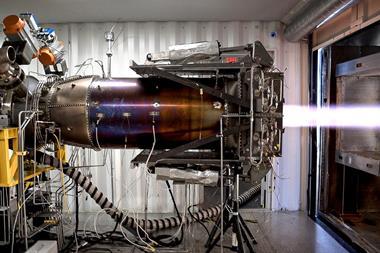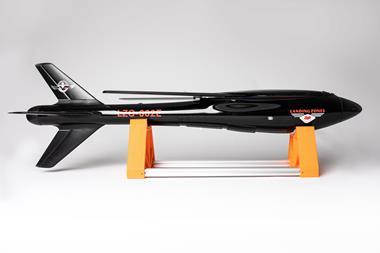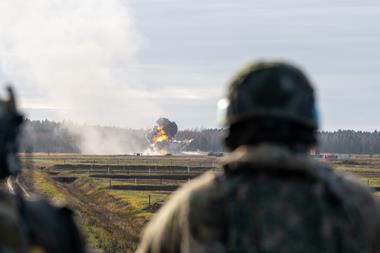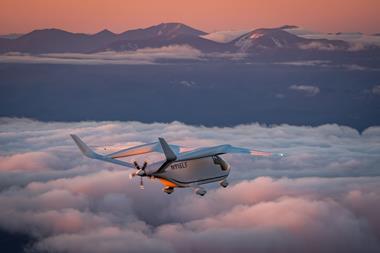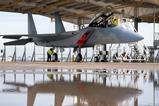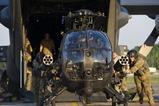US hypersonic flight developer Hermeus has begun taxi testing on the company’s first flight vehicle, as seen in recently released footage.
The Atlanta-based manufacturer posted video to multiple social media platforms showing the chrome-coloured Quarterhorse Mk 1 moving up and down a runway during what Hermeus describes as medium- and high-speed taxi runs.
“We’re getting a lot of reps in taxi testing Quarterhorse Mk 1,” Hermeus said on 22 August. “These repeated runs allow us to gather data on all integrated systems.”
The company had teased the first flight of the Mk 1 typer earlier this year, saying in March that the single-engined jet would “take to the skies” at Edwards AFB in the upcoming summer months.
However, that schedule now appears to have been delayed, as footage from taxi testing shows lush greenery not found at the desert air base in California, which is home to the US Air Force’s (USAF’s) flight test programme.
Hermeus declined to reveal the exact location of the tests, but did confirm to FlightGlobal that subsequent taxi testing would be carried out at a new company site in Jacksonville, Florida. The Mk 1 will then move on to flight trials at Edwards, which Hermeus expects to begin in the coming months.
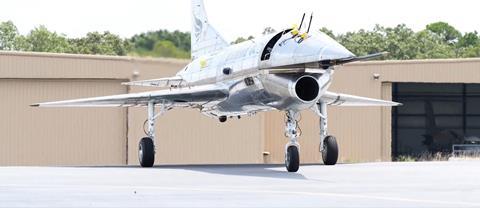
In November 2023, the Pentagon’s Defense Innovation Unit provided Hermeus with research and development funding to support the maturation of hypersonic technologies and development of a flight vehicle.
The unmanned Mk 1 is the first flight-capable vehicle in the Quarterhorse line and the second overall, preceded by the ground-based Quarterhorse Mk 0 test article. Previous ground testing on the Mk 0 took place at the USAF’s Arnold Engineering Development Complex in Tullahoma, Tennessee.
Hermeus plans to use the subsonic Mk 1 as stepping stone toward its ultimate goal of breaking the Mach 5 hypersonic barrier with the forthcoming Quarterhorse Mk 3. A supersonic-capable Quarterhorse Mk 2 design will serve as a bridge between those two aircraft.
The start-up has set the goal of making the Mk 3 the world’s fastest aircraft, by breaking the airspeed record established by Lockheed’s SR-71 Blackbird nearly 50 years ago.
In 1976, one of the twin-engined Blackbirds reached a velocity of 1,905kt (3,529km/h) – or M3.3, according to the USA’s Smithsonian National Air and Space Museum.
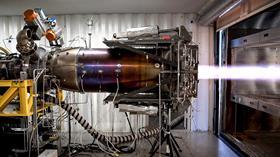
To achieve that, Hermeus is focusing heavily on rapid development of new aircraft designs.
“One aircraft per year,” the company said of its target in April.
The Quarterhorse Mk 0 was designed and built in under six months, while the process took just seven months for the Mk 1 vehicle, according to Hermeus.
Design work is already underway on the supersonic Mk 2 type, which will be powered by a Pratt & Whitney F100 turbofan, feature a delta wing with variable air intakes and be roughly the same size as a Lockheed Martin F-16 fighter.
The company is also experimenting with a proprietary pre-cooler system that will be featured on the Mk 2 and Mk 3 Quarterhorse vehicles. While Hermeus has not revealed specific details, the technology will be critical to achieving hypersonic flight.
Pre-cooling refers to the chilling of engine intake air before compression and combustion. Colder intake air allows standard turbojet jet engines to operate at higher speeds, with greater efficiency and reduced performance degradation.
Although Hermeus has not revealed design specifics, pre-cooling can be accomplished using a heat exchanger and a cryogenic fuel, such as liquid hydrogen.
Such a system is an integral part of the Hermeus approach to breaking the M5 hypersonic barrier, which involves accelerating to low-Mach flight with the use of a standard jet engine, before transitioning to a separate ramjet propulsion system to reach hypersonic speeds.
Story updated 29 August with additional details of the Quarterhorse Mk 1 testing schedule






















